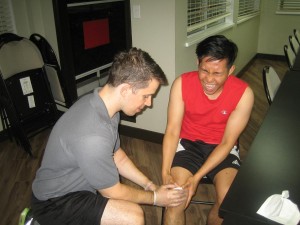Tetanus is a condition caused by anaerobic bacterium known as Clostridium Tetani which gains entry into a person’s body, typically through an open wound. The bacteria will thrive in the person’s body and produce toxins that cause a disease. Tetanus sometimes develops after cuts with dirty, rusty objects or deep punctures from stepping on a nail. It may also develop from clean superficial wounds. The signs and symptoms of tetanus includes muscle spasms beginning in the jaw and neck, inability to open the mouth (lockjaw), swallowing problems, breathing problems, painful convulsions and abnormal heart rhythms. Other symptoms include irritability, headache, fever, sore throat, and stiffness in the neck, arms and legs.
Who are at risk for tetanus?
Anyone who has not received vaccination against tetanus is at risk. Others include people who are working in soil, dust or horses, intravenous drug users and people who have high risk wounds. Those with high risk wounds are most likely to encourage the growth of the anaerobic bacteria. These include compound fractures, burns, animal bites, any type of penetrating wounds such as from rusty nails or thorns and wounds contaminated with soil, manure, or foreign objects such as wood fragments.
Proper wound care

- Wash the would immediately with soap and water
- Remove any obstructing jewelry or clothing around the wound or the injured area
- Avoid touching the wound with fingers while treating it
- Apply direct pressure to any bleeding wound to control bleeding.
- Examine the wound for any dirt and foreign objects
- Gently wash the wound thoroughly preferably with running water and soap (but avoid contacting directly the soap with the wound as It may be irritating), include the surrounding areas as well.
- If there are debris in the wound, try to remove it with tweezers properly disinfected
- Apply a thin layer of antibiotic cream to discourage infection
- Pat the wound dry and apply an adhesive bandage or dry clean cloth
- Get a tetanus shot (every 10 years)
Seek medical attention immediately if:
- There is a foreign object penetrating in the wound
- High risk wounds
- Previous wound that shows signs of becoming infected (increased pain, swelling, redness, drainage and fever)
Prompt first aid management for wounds and prevention of infection is very important. If the person obtained a wound from any penetrating object contaminated with soil, feces, saliva or any debris for that matter, health care professionals should determine if a tetanus booster may be necessary.